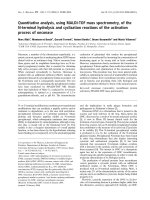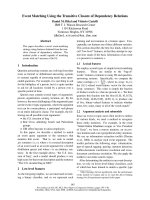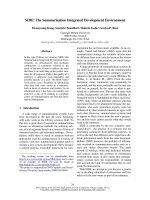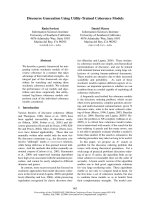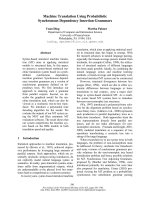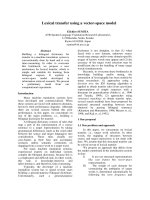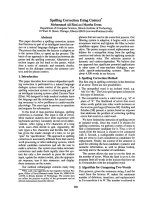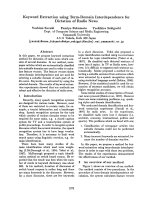Báo cáo khoa học: "Query-Relevant Summarization using FAQs" ppt
Bạn đang xem bản rút gọn của tài liệu. Xem và tải ngay bản đầy đủ của tài liệu tại đây (248.65 KB, 8 trang )
Query-Relevant Summarization using FAQs
Adam Berger Vibhu O. Mittal
School of Computer Science Just Research
Carnegie Mellon University 4616 Henry Street
Pittsburgh, PA 15213 Pittsburgh, PA 15213
Abstract
This paper introduces a statistical model for
query-relevant summarization: succinctly
characterizing the relevance of a document
to a query. Learning parameter values for
the proposed model requires a large collec-
tion of summarized documents, which we
do not have, but as a proxy, we use a col-
lection of FAQ (frequently-asked question)
documents. Taking a learning approach en-
ables a principled, quantitative evaluation
of the proposed system, and the results of
some initial experiments—on a collection
of Usenet FAQs and on a FAQ-like set
of customer-submitted questions to several
large retail companies—suggest the plausi-
bility of learning for summarization.
1 Introduction
An important distinction in document summarization
is between generic summaries, which capture the cen-
tral ideas of the document in much the same way that
the abstract of this paper was designed to distill its
salient points, and query-relevant summaries, which
reflect the relevance of a document to a user-specified
query. This paper discusses query-relevant summa-
rization, sometimes also called “user-focused summa-
rization” (Mani and Bloedorn, 1998).
Query-relevant summaries are especially important
in the “needle(s) in a haystack” document retrieval
problem: a user has an information need expressed
as a query (What countries export smoked
salmon?), and a retrieval system must locate within
a large collection of documents those documents most
likely to fulfill this need. Many interactive retrieval
systems—web search engines like Altavista, for
instance—present the user with a small set of candi-
date relevant documents, each summarized; the user
must then perform a kind of triage to identify likely
relevant documents from this set. The web page sum-
maries presented by most search engines are generic,
not query-relevant, and thus provide very little guid-
ance to the user in assessing relevance. Query-relevant
summarization (QRS) aims to provide a more effective
characterization of a document by accounting for the
user’s information need when generating a summary.
Search for
relevant
documents
Summarize
documents
relative to
Q
σ
σ
σ
σ
(a) (b)
Figure 1: One promising setting for query-relevant sum-
marization is large-scale document retrieval. Given a user
query
, search engines typically first (a) identify a set of
documents which appear potentially relevant to the query,
and then (b)produce a short characterization
of each
document’s relevance to
. The purpose of is to as-
sist the user in finding documents that merit a more detailed
inspection.
As with almost all previous work on summarization,
this paper focuses on the task of extractive summariza-
tion: selecting as summaries text spans—either com-
plete sentences or paragraphs—from the original doc-
ument.
1.1 Statistical models for summarization
From a document and query , the task of query-
relevant summarization is to extract a portion from
which best reveals how the document relates to
the query. To begin, we start with a collection of
triplets, where is a human-constructedsum-
mary of relative to the query . From such a collec-
Snow is
not unusual
in France
D
1
S
1
Q
1
=
Weather in Paris
in December
D
2
Some parents
elect to teach
their children
at home
S
2
Q
2
=
Home
schooling
D
3
Good Will
Hunting is
about
S
3
Q
3
=
Academy award
winners in 1998
Figure 2: Learning to perform query-relevant summariza-
tion requires a set of documents summarized with respect to
queries. Here we show three imaginary triplets
,
but the statistical learning techniques described in Section 2
require thousands of examples.
tion of data, we fit the best function
mapping document/query pairs to summaries.
The mapping we use is a probabilistic one, meaning
the system assigns a value to every possible
summary of . The QRS system willsummarize
a pair by selecting
def
There are at least two ways to interpret .
First, one could view as a “degree of be-
lief” that the correct summary of relative to is .
Of course, what constitutes a good summary in any
setting is subjective: any two people performing the
same summarization task will likelydisagree on which
part of the document to extract. We could, in principle,
ask a large number of people to perform the same task.
Doing so would impose a distribution over
candidate summaries. Under the second, or “frequen-
tist” interpretation, is the fraction of people
who would select —equivalently, the probability that
a person selected at random wouldprefer as the sum-
mary.
The statistical model is parametric, the
values of which are learned by inspection of the
triplets. The learning process involves
maximum-likelihood estimation of probabilistic lan-
guage models and the statistical technique of shrink-
age (Stein, 1955).
This probabilistic approach easily generalizes to
the generic summarization setting, where there is no
query. In that case, the training data consists of
pairs, where is a summary of the document . The
goal, in this case, is to learn and apply a mapping
from documents to summaries. That is,
A single
FAQ
document
Summary of
document with
respect to Q
2
. . .
What is amniocentesis?
Amniocenteses, or amnio, is
a prenatal test in which
What can it detect?
One of the main uses of
amniocentesis is to detect
chromosomal abnormalities
What are the risks of amnio?
The main risk of amnio is
that it may increase the
chance of miscarriage
Figure 3: FAQs consist of a list of questions and answers
on a single topic; the FAQ depicted here is part of an in-
formational document on amniocentesis. This paper views
answers in a FAQ as different summaries of the FAQ: the an-
swer to the
th question is a summary of the FAQ relative to
that question.
find
def
1.2 Using FAQ data for summarization
We have proposed using statistical learning to con-
struct a summarization system, but have not yet dis-
cussed the one crucial ingredient of any learning pro-
cedure: training data. The ideal training data would
contain a large number of heterogeneous documents, a
large number of queries, and summaries of each doc-
ument relative to each query. We know of no such
publicly-available collection. Many studies on text
summarization have focused on the task of summariz-
ing newswire text, but there is no obvious way to use
news articles for query-relevant summarization within
our proposed framework.
In this paper, we propose a novel data collection
for training a QRS model: frequently-asked question
documents. Each frequently-asked question document
(FAQ) is comprised of questions and answers about
a specific topic. We view each answer in a FAQ as
a summary of the document relative to the question
which preceded it. That is, an FAQ with
ques-
tion/answer pairs comes equipped with different
queries and summaries: the answer to the th ques-
tion is a summary of the document relative to the th
question. While a somewhat unorthodox perspective,
this insight allows us to enlist FAQs as labeled train-
ing data for the purpose of learning the parameters of
a statistical QRS model.
FAQ data has some properties that make it particu-
larly attractive for text learning:
There exist a large number of Usenet FAQs—
several thousand documents—publicly available
on the Web
1
. Moreover, many large compa-
nies maintain their own FAQs to streamline the
customer-response process.
FAQs are generally well-structured documents,
so the task of extracting the constituent parts
(queries and answers) is amenable to automation.
There have even been proposals for standardized
FAQ formats, such as RFC1153 and the Minimal
Digest Format (Wancho, 1990).
Usenet FAQs cover an astonishingly wide variety
of topics, ranging from extraterrestrial visitors to
mutual-fund investing. If there’s an online com-
munity of people with a common interest, there’s
likely to be a Usenet FAQ on that subject.
There has been a small amount of published work
involving question/answer data, including (Sato and
Sato, 1998) and (Lin, 1999). Sato and Sato used FAQs
as a source of summarization corpora, although in
quite a different context than that presented here. Lin
used the datasets from a question/answer task within
the Tipster project, a dataset of considerably smaller
size than the FAQs we employ. Neither of these paper
focused on a statistical machine learning approach to
summarization.
2 A probabilistic model of
summarization
Given a query and document , the query-relevant
summarization task is to find
the a posteriori most probable summary for .
Using Bayes’ rule, we can rewrite this expression as
relevance fidelity
(1)
where the lastline follows by droppingthe dependence
on in .
Equation (1) is a search problem: find the summary
which maximizes the product of two factors:
1. The relevance of the query to the sum-
mary: A document may contain some portions
directly relevant to the query, and other sections
bearing little or no relation to the query. Con-
sider, for instance, the problem of summarizing a
1
Two online sources for FAQ data are www.faqs.org
and rtfm.mit.edu.
survey on the history of organized sports relative
to the query “Who was Lou Gehrig?” A summary
mentioning Lou Gehrig is probably more relevant
to this query than one describing the rules of vol-
leyball, even if two-thirds of the survey happens
to be about volleyball.
2. The fidelity of the summary to the
document: Among a set of candidate sum-
maries whose relevance scores are comparable,
we should prefer that summary which is most
representative of the document as a whole. Sum-
maries of documents relative to a query can of-
ten mislead a reader into overestimating the rel-
evance of an unrelated document. In particular,
very long documents are likely (by sheer luck)
to contain some portion which appears related to
the query. A document having nothing to do with
Lou Gehrig may include a mention of his name
in passing, perhaps in the context of amyotropic
lateral sclerosis, the disease from which he suf-
fered. The fidelity term guards against this occur-
rence by rewarding or penalizing candidate sum-
maries, depending on whether they are germane
to the main theme of the document.
More generally, the fidelity term represents a
prior, query-independent distribution over candi-
date summaries. In addition to enforcing fidelity,
this term could serve to distinguish between more
and less fluent candidate summaries, in much the
same way that traditional language models steer a
speech dictation system towards more fluent hy-
pothesized transcriptions.
In words, (1) says that the best summary of a doc-
ument relative to a query is relevant to the query (ex-
hibits a large
value) and also representative of
the document from which it was extracted (exhibits a
large value). We now describe the paramet-
ric form of these models, and how one can determine
optimal values for these parameters using maximum-
likelihood estimation.
2.1 Language modeling
The type of statistical model we employ for both
and is a unigram probability distri-
bution over words; in other words, a language model.
Stochastic models of language have been used exten-
sively in speech recognition, optical character recogni-
tion, and machine translation (Jelinek, 1997; Berger et
al., 1994). Language models have also started to find
their way into document retrieval (Ponte and Croft,
1998; Ponte, 1998).
The fidelity model
One simple statistical characterization of an -word
document is the frequency of
each word in —in other words, a marginal distribu-
tion over words. That is, if word appears times in
, then . This is not only intuitive, but
also the maximum-likelihood estimate for .
Now imagine that, when asked to summarize rel-
ative to , a person generates a summary from in the
following way:
Select a length for the summary according to
some distribution .
Do for :
– Select a word at random according to the
distribution . (That is, throw all the words
in into a bag, pull one out, and then re-
place it.)
– Set .
In followingthis procedure, the personwill generate
the summary
with probability
(2)
Denoting by the set of all known words, and by
the number of times that word appears in
, one can also write (2) as a multinomial distribution:
(3)
In the text classification literature, this characteriza-
tion of is knownas a “bag ofwords” model, since the
distribution does not take account of the order of
the words within thedocument , but rather views as
an unordered set (“bag”) of words. Of course, ignoring
word order amounts to discarding potentially valuable
information. In Figure 3, for instance, the second ques-
tion contains an anaphoric reference to the preceding
question: a sophisticated context-sensitive model of
language might be able to detect that it in this context
refers to amniocentesis, but a context-free model
will not.
The relevance model
In principle, one could proceed analogously to (2),
and take
(4)
for a length- query . But this strat-
egy suffers from a sparse estimation problem. In con-
trast to a document, which we expect will typically
contain a few hundred words, a normal-sized summary
contains just a handful of words. What this means is
that will assign zero probability to most words, and
Figure 4: The relevance of a query to the th an-
swer in document
is a convex combination of five distribu-
tions: (1) a uniform model . (2) a corpus-wide model ;
(3) a model
constructed from the document containing
; (4) a model constructed from and the neigh-
boring sentences in
; (5) a model constructed from
alone. (The distribution is omitted for clarity.)
any query containing a word not in the summary will
receive a relevance score of zero.
(The fidelity model doesn’t suffer from zero-
probabilities, at least not in the extractive summariza-
tion setting. Since a summary
is part of its contain-
ing document , every word in also appears in ,
and therefore for every word . But
we have no guarantee, for the relevance model, that a
summary contains all the words in the query.)
We address this zero-probability problem by inter-
polating or “smoothing” the
model with four more
robustly estimated unigram word models. Listed in
order of decreasing variance but increasing bias away
from , they are:
: a probability distribution constructed using
not only , but also all words within the six sum-
maries (answers) surrounding in . Since
is calculated using more text than just alone, its
parameter estimates should be more robust that
those of . On the other hand, the model is,
by construction, biased away from , and there-
fore provides only indirect evidence for the rela-
tion between and .
: a probabilitydistribution constructed over the
entire document containing . This model has
even less variance than , but is even more bi-
ased away from .
: a probability distribution constructed over all
documents .
: the uniform distribution over all words.
Figure 4 is a hierarchical depiction of the various
language models which come into play in calculating
. Each summary model lives at a leaf node,
and the relevance of a query to that summary is
a convex combination of the distributions at each node
Algorithm:
Shrinkage for estimation
Input: Distributions ,
(not used to
estimate )
Output Model weights
1. Set
2. Repeat until converges:
3. Set for
5. (E-step)
(similarly for )
6. (M-step)
(similarly for )
along a path from the leaf to the root
2
:
(5)
We calculate the weighting coefficients
using the statistical technique
known as shrinkage (Stein, 1955), a simple form of
the EM algorithm (Dempster et al., 1977).
As a practical matter, if one assumes the model
assigns probabilities independently of , then we can
drop the
term when ranking candidate summaries,
since the score of all candidate summaries will re-
ceive an identical contribution from the term. We
make this simplifying assumption in the experiments
reported in the following section.
3 Results
To gauge how well our proposed summarization tech-
nique performs, we applied it to two different real-
world collections of answered questions:
Usenet FAQs: A collection of frequently-
asked question documents from the comp.*
Usenet hierarchy. The documents contained
questions/answer pairs in total.
Call-center data: A collection of questions
submitted by customers to the companies Air
Canada, Ben and Jerry, Iomagic, and Mylex,
along with the answers supplied by company
2
By incorporating a model into the relevance model,
equation (6) has implicitly resurrected the dependence on
which we dropped, for the sake of simplicity, in deriving (1).
representatives. These four documents contain
question/answer pairs.
We conducted an identical, parallel set of experi-
ments on both. First, we used a randomly-selected
subset of 70% of the question/answer pairs to calcu-
late the language models —a simple
matter of counting word frequencies. Then, we used
this same set of data to estimate the model weights
using shrinkage. We re-
served the remaining 30% of the question/answerpairs
to evaluate the performance of the system, in a manner
described below.
Figure 5 shows the progress of the EM algo-
rithm in calculating maximum-likelihood values for
the smoothing coefficients , for the first of the three
runs on the Usenet data. The quick convergence and
the final values were essentially identical for the
other partitions of this dataset.
The call-center data’s convergence behavior was
similar, although the final
values were quite differ-
ent. Figure 6 shows the final model weights for the
first of the three experiments on both datasets. For
the Usenet FAQ data, the corpus language model is the
best predictor of the query and thus receives the high-
est weight. This may seem counterintuitive; one might
suspect that answer to the query (
, that is) would be
most similar to, and therefore the best predictor of,
the query. But the corpus model, while certainly bi-
ased away from the distribution of words found in the
query, contains (by construction) no zeros, whereas
each summary model is typically very sparse.
In the call-center data, the corpus model weight
is lower at the expense of a higher document model
weight. We suspect this arises from the fact that the
documents in the Usenet data were all quite similar to
one another in lexical content, in contrast to the call-
center documents. As a result, in the call-center data
the document containing will appear much more rel-
evant than the corpus as a whole.
To evaluate the performance of the trained QRS
model, we used the previously-unseen portion of the
FAQ data in the following way. For each test
pair, we recorded how highly the system ranked the
correct summary —the answer to in —relative
to the other answers in . We repeated this entire se-
quence three times for both the Usenet and the call-
center data.
For these datasets, we discovered that using a uni-
form fidelity term in place of the model de-
scribed above yields essentially the same result. This
is not surprising: while the fidelity term is an important
component of a real summarization system, our evalu-
ation was conducted in an answer-locating framework,
and in this context the fidelity term—enforcingthat the
summary be similar to the entire document from which
0
0.1
0.2
0.3
0.4
0.5
1 2 3 4 5 6 7 8 9 10
iteration
model weight
uniform corpus FAQ nearby answers answer
-6.9
-6.8
-6.7
-6.6
-6.5
-6.4
-6.3
1 2 3 4 5 6 7 8 9 10
Iteration
Log-likelihood
Test Training
Figure 5: Estimating the weights of the five constituent modelsin (6) using the EM algorithm. The values here were computed
using a single, randomly-selected 70% portion of the Usenet FAQ dataset. Left: The weights for the models are initialized to
, but within a few iterations settle to their final values. Right: The progression of the likelihood of the training data during
the execution of the EM algorithm; almost all of the improvement comes in the first five iterations.
Usenet FAQ
call-center
Summary
29%
Neighbors
10%
Document
14%
Corpus
47%
Uniform
0%
Summary
11%
Neighbors
0%
Document
40%
Corpus
42%
Uniform
7%
Figure 6: Maximum-likelihood weights for the various
components of the relevance model
. Left: Weights
assigned to the constituent models from the Usenet FAQ
data. Right: Corresponding breakdown for the call-center
data. These weights were calculated using shrinkage.
it was drawn—is not so important.
From a set of rankings , one can
measure the the quality of a ranking algorithm using
the harmonic mean rank:
def
A lower number indicates better performance; ,
which is optimal, means that the algorithm consis-
tently assigns the first rank to the correct answer. Ta-
ble 1 shows the harmonic mean rank on the two col-
lections. The third column of Table 1 shows the result
of a QRS system using a uniform fidelity model, the
fourth corresponds to a standard tfidf-based ranking
method (Ponte, 1998), and the last column reflects the
performance of randomly guessing the correct sum-
mary from all answers in the document.
trial # trials LM tfidf random
Usenet 1 554 1.41 2.29 4.20
FAQ 2 549 1.38 2.42 4.25
data 3 535 1.40 2.30 4.19
Call 1 1020 4.8 38.7 1335
center 2 1055 4.0 22.6 1335
data 3 1037 4.2 26.0 1321
Table 1: Performance of query-relevant extractive summa-
rization on the Usenet and call-center datasets. The numbers
reported in the three rightmost columns are harmonic mean
ranks: lower is better.
4 Extensions
4.1 Question-answering
The reader may by nowhave realized that our approach
to the QRS problem may be portable to the problem of
question-answering. By question-answering, we mean
a system which automatically extracts from a poten-
tially lengthy document (or set of documents) the an-
swer to a user-specified question. Devising a high-
quality question-answering system would be of great
service to anyone lacking the inclination to read an
entire user’s manual just to find the answer to a sin-
gle question. The success of the various automated
question-answering services on the Internet (such as
AskJeeves) underscores the commercial importance
of this task.
One can cast answer-finding as a traditional docu-
ment retrieval problem by considering each candidate
answer as an isolated document and ranking each can-
didate answer by relevance to the query. Traditional
tfidf-based ranking of answers will reward candidate
answers with many words in common with the query.
Employing traditional vector-space retrieval to find an-
swers seems attractive, since tfidf is a standard, time-
tested algorithm in the toolbox of any IR professional.
What this paper has described is a first step towards
more sophisticated models of question-answering.
First, we have dispensed with the simplifying assump-
tion that the candidate answers are independent of one
another by using a model which explicitly accounts
for the correlation between text blocks—candidate
answers—within a single document. Second, we have
put forward a principled statistical model for answer-
ranking; has a probabilistic in-
terpretation as the best answer to within is .
Question-answering and query-relevant summariza-
tion are of course not one and the same. For one, the
criterion of containing an answer to a question is rather
stricter than mere relevance. Put another way, only a
small number of documents actually contain the an-
swer to a given query, while every document can in
principle be summarized with respect to that query.
Second, it would seem that the term, which
acts as a prior on summaries in (1), is less appropriate
in a question-answering setting, where it is less impor-
tant that a candidate answer to a query bears resem-
blance to the document containing it.
4.2 Generic summarization
Although this paper focuses on the task of query-
relevant summarization, the core ideas—formulating
a probabilistic model of the problem and learning
the values of this model automatically from FAQ-like
data—are equally applicable to generic summariza-
tion. In this case, one seeks the summary which best
typifies the document. Applying Bayes’ rule as in (1),
generative prior
(6)
The first term on the right is a generative model of doc-
uments from summaries, and the second is a prior dis-
tribution over summaries. One can think of this factor-
ization in terms of a dialogue. Alice, a newspaper edi-
tor, has an idea for a story, which she relates to Bob.
Bob researches and writes the story , which we can
view as a “corruption” of Alice’s original idea . The
task of generic summarization is to recover , given
only the generated document , a model of
how the Alice generates summaries from documents,
and a prior distribution on ideas .
The central problem in information theory is reliable
communication through an unreliable channel. We can
interpret Alice’s idea
as the original signal, and the
process by which Bob turns this idea into a document
as the channel, which corrupts the original message.
The summarizer’s task is to “decode” the original, con-
densed message from the document.
We point out this source-channel perspective be-
cause of the increasing influence that information the-
ory has exerted on language and information-related
applications. For instance, the source-channel model
has been used for non-extractive summarization, gen-
erating titles automatically from news articles (Wit-
brock and Mittal, 1999).
The factorizationin (6) is superficially similar to (1),
but there is an important difference: is a gener-
ative, from a summary to a larger document, whereas
is compressive, from a summary to a smaller
query. This distinction is likely to translate in prac-
tice into quite different statistical models and training
procedures in the two cases.
5 Summary
The task of summarization is difficult to define and
even more difficult to automate. Historically, a re-
warding line of attack for automating language-related
problems has been to take a machine learning perspec-
tive: let a computer learn how to perform the task by
“watching” a human perform it many times. This is
the strategy we have pursued here.
There has been some work on learning a probabilis-
tic model of summarization from text; some of the ear-
liest work on this was due to Kupiec et al. (1995),
who used a collection of manually-summarized text
to learn the weights for a set of features used in a
generic summarization system. Hovy and Lin (1997)
present another system that learned how the position
of a sentence affects its suitability for inclusion in
a summary of the document. More recently, there
has been work on building more complex, structured
models—probabilistic syntax trees—to compress sin-
gle sentences (Knight and Marcu, 2000). Mani and
Bloedorn (1998) have recently proposed a method for
automatically constructing decision trees to predict
whether a sentence should or should not be included
in a document’s summary. These previous approaches
focus mainly on the generic summarization task, not
query relevant summarization.
The language modelling approach described here
does suffer from a common flaw within text processing
systems: the problem of synonymy. A candidate an-
swer containingthe term Constantinople is likely
to be relevant to a question about Istanbul, but rec-
ognizing this correspondence requires a step beyond
word frequency histograms. Synonymy has received
much attention within the document retrieval com-
munity recently, and researchers have applied a vari-
ety of heuristic and statistical techniques—including
pseudo-relevance feedback and local context analy-
sis (Efthimiadis and Biron, 1994; Xu and Croft, 1996).
Some recent work in statistical IR has extended the ba-
sic language modellingapproaches to account for word
synonymy (Berger and Lafferty, 1999).
This paper has proposed the use of two novel
datasets for summarization: the frequently-asked
questions (FAQs) from Usenet archives and ques-
tion/answer pairs from the call centers of retail compa-
nies. Clearly this data isn’t a perfect fit for the task of
building a QRS system: after all, answers are not sum-
maries. However, we believe that the FAQs represent a
reasonable source of query-related document conden-
sations. Furthermore, using FAQs allows us to assess
the effectiveness of applying standard statistical learn-
ing machinery—maximum-likelihood estimation, the
EM algorithm, and so on—to the QRS problem. More
importantly, it allows us to evaluate our results in a rig-
orous, non-heuristic way. Although this work is meant
as an opening salvo in the battle to conquer summa-
rization with quantitative, statistical weapons, we ex-
pect in the future to enlist linguistic, semantic, and
other non-statistical tools which have shown promise
in condensing text.
Acknowledgments
This research was supported in part by an IBM Univer-
sity Partnership Award and by Claritech Corporation.
The authors thank Right Now Tech for the use of the
call-center question database. We also acknowledge
thoughtful comments on this paper by Inderjeet Mani.
References
A. Berger and J. Lafferty. 1999. Information retrieval
as statistical translation. In Proc. of ACM SIGIR-99.
A. Berger, P. Brown, S. Della Pietra, V. Della Pietra,
J. Gillett, J. Lafferty, H. Printz, and L. Ures. 1994.
The CANDIDE system for machine translation. In
Proc. of the ARPA Human Language Technology
Workshop.
Y. Chali, S. Matwin, and S.Szpakowicz. 1999. Query-
biased text summarization as a question-answering
technique. In Proc. of the AAAI Fall Symp. on Ques-
tion Answering Systems, pages 52–56.
A. Dempster, N. Laird, and D. Rubin. 1977. Max-
imum likelihood from incomplete data via the EM
algorithm. Journal of the Royal Statistical Society,
39B:1–38.
E. Efthimiadis and P. Biron. 1994. UCLA-Okapi at
TREC-2: Query expansion experiments. In Proc. of
the Text Retrieval Conference (TREC-2).
E. Hovy and C. Lin. 1997. Automated text summa-
rization in SUMMARIST. In Proc. of the ACL Wkshp
on Intelligent Text Summarization, pages 18–24.
F. Jelinek. 1997. Statistical methods for speech recog-
nition. MIT Press.
K. Knight and D. Marcu. 2000. Statistics-based
summarization—Step one: Sentence compression.
In Proc. of AAAI-00. AAAI.
J. Kupiec, J. Pedersen, and F. Chen. 1995. A trainable
document summarizer. In Proc. SIGIR-95, pages
68–73, July.
Chin-Yew Lin. 1999. Training a selection function
for extraction. In Proc. of the Eighth ACM CIKM
Conference, Kansas City, MO.
I. Mani and E. Bloedorn. 1998. Machine learning of
generic and user-focused summarization. In Proc.
of AAAI-98, pages 821–826.
J. Ponte and W. Croft. 1998. A language modeling ap-
proach to information retrieval. In Proc. of SIGIR-
98, pages 275–281.
J. Ponte. 1998. A language modelling approach to
information retrieval. Ph.D. thesis, University of
Massachusetts at Amherst.
S. Sato and M. Sato. 1998. Rewriting saves extracted
summaries. In Proc. of the AAAI Intelligent Text
Summarization Workshop, pages 76–83.
C. Stein. 1955. Inadmissibility of the usual estimator
for the mean of a multivariate normal distribution.
In Proc. of the Third Berkeley symposium on mathe-
matical statistics and probability, pages 197–206.
F. Wancho. 1990. RFC 1153: Digest message format.
M. Witbrock and V. Mittal. 1999. Headline Genera-
tion: A framework for generating highly-condensed
non-extractive summaries. In Proc. of ACM SIGIR-
99, pages 315–316.
J. Xu and B. Croft. 1996. Query expansion using lo-
cal and global document analysis. In Proc. of ACM
SIGIR-96.
